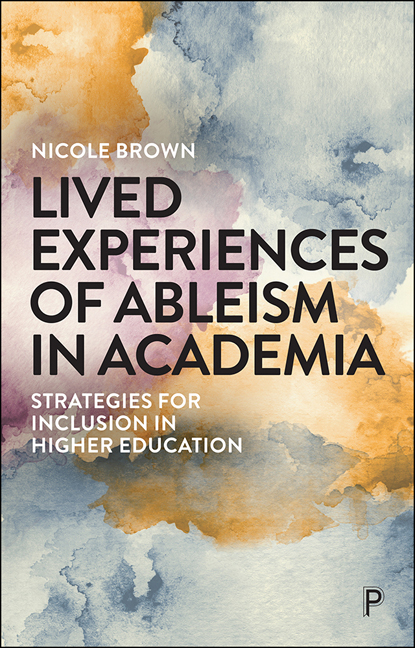5 - Colour blindness in academia: the challenges of an invisible impairment
Published online by Cambridge University Press: 18 December 2021
Summary
Introduction
The majority of people share a common sensory experience in terms of perceiving, naming, discussing and using the colours they see. A sizeable minority of people, however, experience the world differently because they have a more limited perception of colour. Statistics show that 1 in 12 males and 1 in 200 females with Northern European ancestry live with what is colloquially, but inaccurately, known as colour blindness – approximately 4.5 per cent of the population. This means that, globally, hundreds of millions of people are not as aware, if they are aware at all, of differences between colours or hues that the majority of us take for granted: ‘Worldwide, there are approximately 300 million people with colour blindness, almost the same number of people as the entire population of the USA’ (Colour Blind Awareness, 2018a). In the UK, approximately 450,000 children, or one child in every co-educational classroom, are unable to identify many different colours (Scope, 2018) because they have defects in the three kinds of retinal cones that respond to red, blue and green light (National Eye Institute, 2015).
Colour blindness can be brought on by conditions such as diabetes or multiple sclerosis and it can also accompany the natural ageing process in humans (Colour Blind Awareness, 2018a). That said, it is most commonly an inherited condition, one for which there is no known cure. Regarding inherited colour blindness, as the statistics above indicate, males are more likely to be affected than females because the gene responsible is carried in the X chromosome and, unlike females, males do not have a second X chromosome that usually overrides the faulty one. The most common form of colour blindness is red-green confusion; the second most common is blue-yellow confusion; the rarest type is monochromacy, where one sees in shades of grey from black to white (Colour Blind Awareness 2018b).
The purpose of this chapter is to explore the everyday challenges in academia from my perspective as someone who has inherited deuteranomaly (green-deficient cone sensitivity). The first part of the chapter briefly explains the daily lived effects of the condition and how they have impacted negatively on my educational experiences and work as an academic. It includes a ten-point scale of offensive responses when colour blind challenges are raised.
- Type
- Chapter
- Information
- Lived Experiences of Ableism in AcademiaStrategies for Inclusion in Higher Education, pp. 95 - 110Publisher: Bristol University PressPrint publication year: 2021



